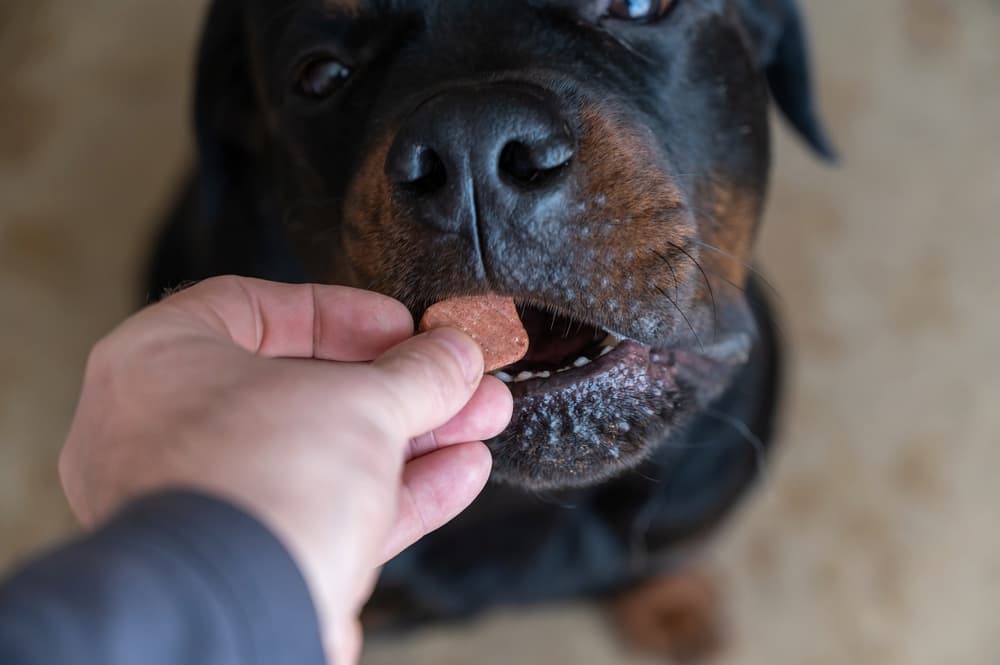Tapeworms in Dogs

Overview
All featured products are chosen at the discretion of the GreatPetCare editorial team and do not reflect a direct endorsement by the author or reviewer.
Tapeworms are common parasites of dogs and cats. They are most commonly acquired by ingesting infected fleas, but may be acquired by hunting small mammals or scavenging as well. Tapeworms can sometimes be seen in your dog’s stool as small, flat, white segments. Fortunately, tapeworms can easily be treated with medication from your veterinarian.
Here’s what you need to know about tapeworms in dogs.
What Is Tapeworm in Dogs?

Tapeworms are parasitic worms that commonly infect dogs and cause intestinal problems. Tapeworms are flat, segmented worms that can grow up to several feet in length. Dogs become infected with tapeworms by ingesting fleas that carry tapeworm larvae or by eating infected rodents or other animals. Once inside the dog’s intestines, the tapeworms attach themselves to the intestinal wall and feed on the host’s digestive contents.
Tapeworm infestations can cause a range of symptoms in dogs, including weight loss, diarrhea, abdominal discomfort, and the presence of rice-like segments in the dog’s feces. In severe cases, tapeworms can also cause blockages in the intestines, leading to more serious health problems.
What Causes Tapeworms in Dogs?

There are three main types of tapeworms that infect dogs and each is transmitted differently:
Diplydium caninum is the most common tapeworm in dogs and is acquired by ingesting an infected flea.
Taenia tapeworm species are acquired by ingesting infected animals, such as rodents and other small mammals.
Echinococcus tapeworm species are typically found in wildlife and may infect dogs who hunt or scavenge.
Can Humans Get Tapeworms From Dogs?
Humans cannot get tapeworms directly from dogs. However, humans could potentially get Diplydium tapeworms from accidentally ingesting an infected flea. Young children are most at risk of contracting tapeworms this way. People who accidentally ingest contaminated soil, food, or water are also at risk of Echinococcus tapeworms.
Tapeworm Symptoms in Dogs

Many dogs with tapeworm infestations are asymptomatic, meaning that pet owners won’t notice any obvious symptoms. Other dogs may have symptoms such as:
- Irritation or itching around the anus
- Visible rice-like segments (proglottids) in the feces, around the anus, or in bedding
- Vomiting
- Diarrhea
- Intestinal obstruction with heavy infestations
Can You See Tapeworms in Dog Poop?
Tapeworm segments may occasionally be visible in the poop of an infected dog. These segments are white or cream colored and may be single or multiple segments. Pet owners often describe them as looking like tiny sesame seeds or grains of rice.
Diagnosing Tapeworms in Dogs

To diagnose tapeworms in your dog, your vet may perform some or all of the following tests:
- Physical Examination. Your vet will perform a comprehensive physical examination on your dog. Sometimes, tapeworms are diagnosed by physical examination alone, if your veterinarian finds tapeworm segments around your dog’s anus or under the tail.
- Fecal Floatation. A sample of your dog’s feces may be checked for tapeworm eggs. This method often has false negative results because shedding of tapeworm eggs occurs intermittently. Multiple tests may be necessary to identify a tapeworm infection.
- Fecal Antigen Test. A fecal antigen test detects flea tapeworm using a sample of your dog’s feces. This test is relatively new and may not be offered by all vet clinics yet.
Tapeworm Treatment for Dogs

If your dog is diagnosed with tapeworms, it is important to treat the infection as soon as possible. Untreated tapeworm infestations can cause malnutrition, anemia, and intestinal blockage. Fortunately, treating tapeworm infections is relatively inexpensive and simple.
Tapeworm Medicine for Dogs
To treat a tapeworm infection, your veterinarian will prescribe medication for your dog such as praziquantel or epsiprantel. The dose of medication prescribed will vary depending on your dog’s weight. It is important to follow your veterinarian’s dosing instructions closely. Your veterinarian may also recommend checking a fecal sample following treatment to ensure that the infection has been cleared.
General Cost
Treating tapeworms is relatively inexpensive. Pet owners can expect to pay $25-$75 to treat tapeworms, depending on the size of the dog and the type of medication chosen.
Tapeworm Prevention for Dogs

Tapeworms are most commonly acquired by ingesting infected fleas. Using year-round flea control, such as Credelio, is a good way to protect against tapeworms in dogs. Credelio is a monthly chewable tablet that kills ticks and fleas fast.
Some monthly heartworm preventives, like Interceptor Plus, also treat and control tapeworm infections. Interceptor Plus is a tasty monthly chew that protects against five types of worms in dogs, including tapeworm and heartworm disease.



By using both a monthly tick and flea medicine and a dewormer for dogs, you can provide 360 degree protection for your canine companion.
Dogs should also be prevented from hunting or scavenging, because tapeworms can be acquired by eating infected rodents or meat.









